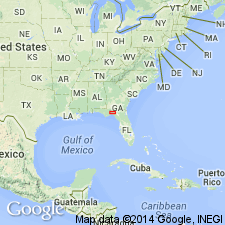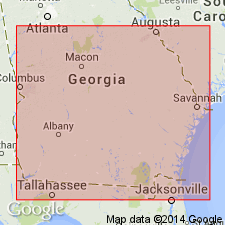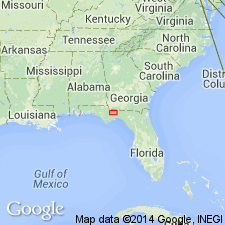
- Usage in publication:
-
- Miccosukee Formation
- Modifications:
-
- Named
- Dominant lithology:
-
- Clay
- Silt
- Sand
- Gravel
- AAPG geologic province:
-
- South GA-North FL sedimentary province
Summary:
Named Miccosukee Formation for Lake Miccosukee and town of Miccosukee, Jefferson Co., FL. Unit composed of continental sediments of interbedded and cross-bedded clays, silts, and sands and gravels of varying coarseness. Formation is not complete on surface exposures; type section is given as a corehole. The Miccosukee is considered of Miocene age.
Source: GNU records (USGS DDS-6; Reston GNULEX).

- Usage in publication:
-
- Miccosukee Formation
- Modifications:
-
- Age modified
- AAPG geologic province:
-
- South GA-North FL sedimentary province
Summary:
Because the Miccosukee Formation is nonfossiliferous, the age must be inferred from its stratigraphic position and physical correlation with adjacent deposits. Miccosukee Formation occurs in the same stratigraphic position and is lithologically the same as the Cypresshead Formation (new name) in eastern GA. It is therefore presumed that the two units are time-equivalent. Miccosukee is also correlative, at least in part, with the Nashua Formation of northeastern FL. The best current estimate of the age range of the unit is from early late Pliocene (early Piacenzian) to early Pleistocene (Calabrian). However, author feels it is more likely that the Miccosukee, like the Cypresshead, is late Pliocene in age.
Source: GNU records (USGS DDS-6; Reston GNULEX).

- Usage in publication:
-
- Miccosukee Formation
- Modifications:
-
- Overview
- Areal extent
- AAPG geologic province:
-
- South Georgia sedimentary province
Summary:
In eastern Gadsden Co., AL, the Miccosukee Formation is somewhat similar in overall lithology to the time equivalent Citronelle Formation, but the former is generally composed of fine-to-medium grained clayey sands with few gravels, while the latter is clayey, medium to coarse-grained quartz sands with clay lenses and beds of quartz pebbles. The Little River may be used as an arbitrary transition line between the two formations. Miccosukee Formation lithology is found in a few locations west of the river, however. Accurate age dating is impossible because of the lack of index fossils. Unit overlies the late Pliocene Jackson Bluff Formation in Leon Co. and is itself considered to be late Pliocene. In Gadsden Co. and northeastward into GA, the Miccosukee unconformably overlies the Miocene Torreya Formation. Unit pinches out in eastern Madison Co. Thickness reaches 44 ft in northeastern Gadsden Co.
Source: GNU records (USGS DDS-6; Reston GNULEX).
For more information, please contact Nancy Stamm, Geologic Names Committee Secretary.
Asterisk (*) indicates published by U.S. Geological Survey authors.
"No current usage" (†) implies that a name has been abandoned or has fallen into disuse. Former usage and, if known, replacement name given in parentheses ( ).
Slash (/) indicates name conflicts with nomenclatural guidelines (CSN, 1933; ACSN, 1961, 1970; NACSN, 1983, 2005, 2021). May be explained within brackets ([ ]).

